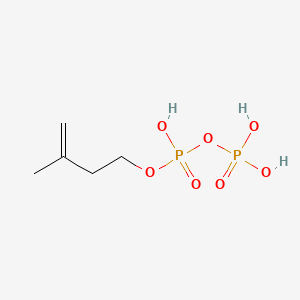| Morrone D et al. |
Increasing diterpene yield with a modular metabolic engineering system in E. coli: comparison of MEV and MEP isoprenoid precursor pathway engineering. |
2010 |
Appl. Microbiol. Biotechnol. |
pmid:19777230
|
| Urzúa U et al. |
Tumor and reproductive traits are linked by RNA metabolism genes in the mouse ovary: a transcriptome-phenotype association analysis. |
2010 |
BMC Genomics |
pmid:21210965
|
| Piepho M et al. |
Simultaneous effects of light intensity and phosphorus supply on the sterol content of phytoplankton. |
2010 |
PLoS ONE |
pmid:21209879
|
| Wang C et al. |
Farnesol production from Escherichia coli by harnessing the exogenous mevalonate pathway. |
2010 |
Biotechnol. Bioeng. |
pmid:20552672
|
| Pazianas M et al. |
Long-term treatment with bisphosphonates and their safety in postmenopausal osteoporosis. |
2010 |
Ther Clin Risk Manag |
pmid:20668715
|
| Zhang F et al. |
An L1 box binding protein, GbML1, interacts with GbMYB25 to control cotton fibre development. |
2010 |
J. Exp. Bot. |
pmid:20667961
|
| Yao S et al. |
Differentiation, distribution and gammadelta T cell-driven regulation of IL-22-producing T cells in tuberculosis. |
2010 |
PLoS Pathog. |
pmid:20195465
|
| Schmidt T et al. |
Characterization of rubber particles and rubber chain elongation in Taraxacum koksaghyz. |
2010 |
BMC Biochem. |
pmid:20170509
|
| Rios-Estepa R et al. |
Mathematical modeling-guided evaluation of biochemical, developmental, environmental, and genotypic determinants of essential oil composition and yield in peppermint leaves. |
2010 |
Plant Physiol. |
pmid:20147490
|
| Takaichi S et al. |
Carotenoids of Gemmatimonas aurantiaca (Gemmatimonadetes): identification of a novel carotenoid, deoxyoscillol 2-rhamnoside, and proposed biosynthetic pathway of oscillol 2,2'-dirhamnoside. |
2010 |
Microbiology (Reading, Engl.) |
pmid:19959572
|
| Dolzhenko Y et al. |
UV-B modulates the interplay between terpenoids and flavonoids in peppermint (Mentha x piperita L.). |
2010 |
J. Photochem. Photobiol. B, Biol. |
pmid:20627615
|
| Gresh N et al. |
Analysis of the interactions taking place in the recognition site of a bimetallic Mg(II)-Zn(II) enzyme, isopentenyl diphosphate isomerase. a parallel quantum-chemical and polarizable molecular mechanics study. |
2010 |
J Phys Chem B |
pmid:20329783
|
| Dellas N and Noel JP |
Mutation of archaeal isopentenyl phosphate kinase highlights mechanism and guides phosphorylation of additional isoprenoid monophosphates. |
2010 |
ACS Chem. Biol. |
pmid:20392112
|
| Chen M and Poulter CD |
Characterization of thermophilic archaeal isopentenyl phosphate kinases. |
2010 |
Biochemistry |
pmid:19928876
|
| Hasunuma T et al. |
Metabolic engineering by plastid transformation as a strategy to modulate isoprenoid yield in plants. |
2010 |
Methods Mol. Biol. |
pmid:20552454
|
| Yadav VR et al. |
Targeting inflammatory pathways by triterpenoids for prevention and treatment of cancer. |
2010 |
Toxins (Basel) |
pmid:22069560
|
| Goto T et al. |
Various Terpenoids Derived from Herbal and Dietary Plants Function as PPAR Modulators and Regulate Carbohydrate and Lipid Metabolism. |
2010 |
PPAR Res |
pmid:20613991
|
| Costa GG et al. |
Transcriptome analysis of the oil-rich seed of the bioenergy crop Jatropha curcas L. |
2010 |
BMC Genomics |
pmid:20691070
|
| Narayanasamy P et al. |
Synthesis of 4-diphosphocytidyl-2-C-methyl-D-erythritol 2-phosphate and kinetic studies of Mycobacterium tuberculosis IspF. |
2010 |
Chem. Biol. |
pmid:20189102
|
| Ibrahim MA et al. |
Elevation of night-time temperature increases terpenoid emissions from Betula pendula and Populus tremula. |
2010 |
J. Exp. Bot. |
pmid:20181662
|
